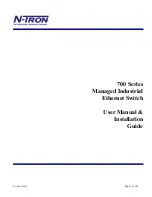
1-32
Digest Snooping configuration example
1) Network
requirements
z
Device A and Device B connect to Device C, a third-party device, and all these devices are in the
same region.
z
Enable Digest Snooping on Device A and Device B so that the three devices can communicate with
one another.
Figure 1-6
Digest Snooping configuration
2) Configuration
procedure
# Enable Digest Snooping on GigabitEthernet 1/0/1 of Device A and enable global Digest Snooping on
Device A.
<DeviceA> system-view
[DeviceA] interface gigabitethernet 1/0/1
[DeviceA-GigabitEthernet1/0/1] stp config-digest-snooping
[DeviceA-GigabitEthernet1/0/1] quit
[DeviceA] stp config-digest-snooping
# Enable Digest Snooping on GigabitEthernet 1/0/1 of Device B and enable global Digest Snooping on
Device B.
<DeviceB> system-view
[DeviceB] interface gigabitethernet 1/0/1
[DeviceB-GigabitEthernet1/0/1] stp config-digest-snooping
[DeviceB-GigabitEthernet1/0/1] quit
[DeviceB] stp config-digest-snooping
Configuring No Agreement Check
In RSTP and MSTP, two types of messages are used for rapid state transition on designated ports:
z
Proposal: sent by designated ports to request rapid transition
z
Agreement: used to acknowledge rapid transition requests
Both RSTP and MSTP devices can perform rapid transition on a designated port only when the port
receives an agreement packet from the downstream device. The differences between RSTP and MSTP
devices are:
z
For MSTP, the downstream device’s root port sends an agreement packet only after it receives an
agreement packet from the upstream device.
z
For RSTP, the down stream device sends an agreement packet regardless of whether an
agreement packet from the upstream device is received.















































